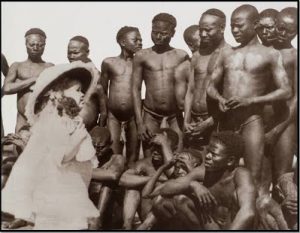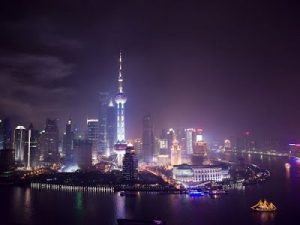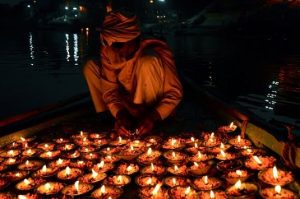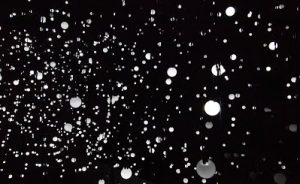Mary Deane, daughter of Census officer, on government steamer with a group of Onges, Little Andaman, 1911. Photograph: H.W Seton Kerr, Source Royal Anthropological Institute photographic collection (Edwards:1992).
19th century anthropological images and texts are littered with the cultural polarisation of light as a Victorian metaphor of colonial illumination that lit up the ‘primitive exotic other’ – namely non western societies living in a backwards state of evolutionary darkness. An excellent selection of debates are located in “Anthropology of Photography 1860-1920” a seminal publication edited by Elizabeth Edwards (1992), which critically discusses the historical role and meaning of the photographic image in the late 19th and early 20th century as a new ethnographic way of seeing the world.
This powerful frontispiece is a prime example of when you can judge a book and its contents by its cover. The photograph reveals Mary Deane the daughter of the Census officer on board a government steamer, aged maybe 6 years old, fully clothed in respectable Victorian attire, a frilly white dress and wide brimmed hat, clutching a doll (equally dressed). Standing in front of young Mary is a semi naked group of Andaman Onges, who are equally staring curiously at this strange white child.
As the gaze is returned, both child and men exude a strange innocence in their lack of comprehension of the other. The perplexed gaze, reductionist debates of racial differences and visual metaphors of light and dark are captured perfectly in this troubling image that reveals the inter-disciplinary dialogue and parallels between anthropology and photography in the 19th and early 20th century.
http://www.jstor.org/discover/10.2307/4618888?uid=3738032&uid=2129&uid=2&uid=70&uid=4&sid=21101734680581
Further references that link the concept of light, dark and space can be traced to various European writers of colonial literature. One of the most cited educational texts is Joseph Conrad’s literary classic “The Heart of Darkness” (org pub.1899) located in the dense, jungle landscape interior of the African Congo. According to most scholars, in Conrad’s Darwinian world, the polarised narrative of black-white, dark-light, savagery-civilization are simultaneously both a mask and illumination for the multilayered darksides, not only of the African geographic continent, but of the injustice of colonialism and exploitation of humanity.
“Darkness is everywhere in the Heart of Darkness. But the novella tweaks the conventional idea of white as good and dark as evil. Evil and good don’t really apply to Heart of Darkness, because everyone in this story is somehow complicit in the atrocities taking place in Africa. Rather, whiteness, especially in the form of the white fog that surrounds the steamship, symbolizes blindness. The dark is symbolized by the huge and inscrutable African jungle, and is associated with the unknowable and primitive heart of all men”. http://www.litcharts.com/files/pdf/printer/heartofdarkness-LitChart.pdf

A Riverside Village, Congo, 1889. Photo from Vingt années de vie africaine: 1874-1893, Photo Alexandre Delcommune, 1922.
Below is a passage that introduces the novella and relationship between the central sea captain Marlow and his discovery of mapping the physical and cultural landscape. There are some notable references here that relate to my academic interest for spatial mapping and indigenous cartography which I look forward to posting in the future.
“Now when I was a little chap I had a passion for maps. I would look for hours at South America, or Africa, or Australia, and lose myself in all the glories of exploration. At that time there were many blank spaces on the earth, and when I saw one that looked particularly inviting on a map (but they all look that) I would put my finger on it and say, ‘When I grow up I will go there.'” – “I have been in some of them, …. But there was one yet—the biggest, the most blank, so to speak—that I had a hankering after. True, by this time it was not a blank space any more. It had got filled since my boyhood with rivers and lakes and names. It had ceased to be a blank space of delightful mystery—a white patch for a boy to dream gloriously over. It had become a place of darkness”.
http://en.wikipedia.org/wiki/Heart_of_Darkness
However, in todays 21st century post modern societies, the rapid global growth of African, Asian and South American continents reveals how the geographic perspective and focus of dark and light has literally and metaphorically shifted. In contrast to the former colonial illumination, the bright lights of global countries such as China, India, and Brazil are now the model of progress, bursting with an economic vitality and visual vibrancy for all.
Whether the purity of fire, or the bathing in candlelight, there are many religions that use the language and beauty of light as a metaphor for illumination, and the eternal guiding light of divinity.
Light and Space Exhibition : Haywood Gallery, London 2013
The aesthetics of light and the effective way human beings relate to illumination through their art is an additional journey, I recently explored at the Haywood Gallery Light Show. This exhibition is curated around the experiential and phenomenal aspects of light by bringing together sculptures and installations that use light to sculpt and shape space in different ways. Light becomes a showcase of artworks created from the 1960s to the present day, including immersive environments, free-standing light sculptures and projections and is one of those experiential, physical exhibitions you will recall due to a wonderful immersion of the senses. From atmospheric installations to intangible sculptures that you can move in, around – and even through light, visitors can experience light in all of its spatial and sensory forms. Individual artworks explore different aspects of light such as colour, duration, intensity and projection, as well as perceptual phenomena, but equally the relationship between light and sprinkling water. Artists also use light to address architecture, science and film, and do so using a variety of colourful lighting technologies.
Light has the power to affect our state of mind as well as alter how we perceive the world around us. Light Show includes some of the most visually stimulating artworks in recent years, re-created especially in the creative space of the Hayward Gallery. The way light is experienced shifts depending on the context, but whether its danger, the romance of moonbeams, or joy of water, go see.
Copyright © 2013 Yasmin-Hales Henao . All Rights Reserved.





Recent Comments